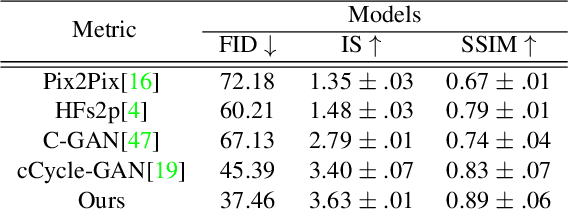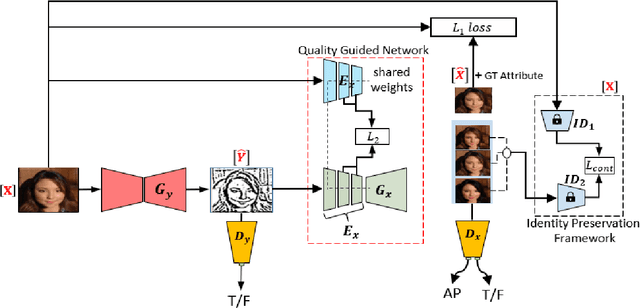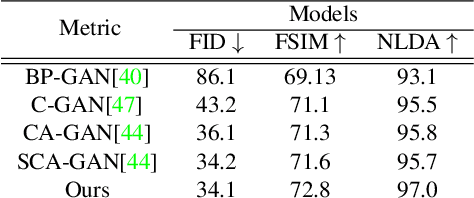Uche Osahor
Quality Map Fusion for Adversarial Learning
Oct 24, 2021



Abstract:Generative adversarial models that capture salient low-level features which convey visual information in correlation with the human visual system (HVS) still suffer from perceptible image degradations. The inability to convey such highly informative features can be attributed to mode collapse, convergence failure and vanishing gradients. In this paper, we improve image quality adversarially by introducing a novel quality map fusion technique that harnesses image features similar to the HVS and the perceptual properties of a deep convolutional neural network (DCNN). We extend the widely adopted l2 Wasserstein distance metric to other preferable quality norms derived from Banach spaces that capture richer image properties like structure, luminance, contrast and the naturalness of images. We also show that incorporating a perceptual attention mechanism (PAM) that extracts global feature embeddings from the network bottleneck with aggregated perceptual maps derived from standard image quality metrics translate to a better image quality. We also demonstrate impressive performance over other methods.
Ortho-Shot: Low Displacement Rank Regularization with Data Augmentation for Few-Shot Learning
Oct 18, 2021



Abstract:In few-shot classification, the primary goal is to learn representations from a few samples that generalize well for novel classes. In this paper, we propose an efficient low displacement rank (LDR) regularization strategy termed Ortho-Shot; a technique that imposes orthogonal regularization on the convolutional layers of a few-shot classifier, which is based on the doubly-block toeplitz (DBT) matrix structure. The regularized convolutional layers of the few-shot classifier enhances model generalization and intra-class feature embeddings that are crucial for few-shot learning. Overfitting is a typical issue for few-shot models, the lack of data diversity inhibits proper model inference which weakens the classification accuracy of few-shot learners to novel classes. In this regard, we broke down the pipeline of the few-shot classifier and established that the support, query and task data augmentation collectively alleviates overfitting in networks. With compelling results, we demonstrated that combining a DBT-based low-rank orthogonal regularizer with data augmentation strategies, significantly boosts the performance of a few-shot classifier. We perform our experiments on the miniImagenet, CIFAR-FS and Stanford datasets with performance values of about 5\% when compared to state-of-the-art
Quality Guided Sketch-to-Photo Image Synthesis
Apr 20, 2020



Abstract:Facial sketches drawn by artists are widely used for visual identification applications and mostly by law enforcement agencies, but the quality of these sketches depend on the ability of the artist to clearly replicate all the key facial features that could aid in capturing the true identity of a subject. Recent works have attempted to synthesize these sketches into plausible visual images to improve visual recognition and identification. However, synthesizing photo-realistic images from sketches proves to be an even more challenging task, especially for sensitive applications such as suspect identification. In this work, we propose a novel approach that adopts a generative adversarial network that synthesizes a single sketch into multiple synthetic images with unique attributes like hair color, sex, etc. We incorporate a hybrid discriminator which performs attribute classification of multiple target attributes, a quality guided encoder that minimizes the perceptual dissimilarity of the latent space embedding of the synthesized and real image at different layers in the network and an identity preserving network that maintains the identity of the synthesised image throughout the training process. Our approach is aimed at improving the visual appeal of the synthesised images while incorporating multiple attribute assignment to the generator without compromising the identity of the synthesised image. We synthesised sketches using XDOG filter for the CelebA, WVU Multi-modal and CelebA-HQ datasets and from an auxiliary generator trained on sketches from CUHK, IIT-D and FERET datasets. Our results are impressive compared to current state of the art.
 Add to Chrome
Add to Chrome Add to Firefox
Add to Firefox Add to Edge
Add to Edge